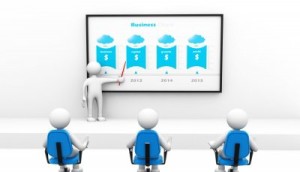 Delivering a memorable presentation to any audience on just about any topic rests on three things: 1) identifying your goal; 2) making your presentation relevant to your audience; and 3) offering them a clear call to action at the conclusion.
Delivering a memorable presentation to any audience on just about any topic rests on three things: 1) identifying your goal; 2) making your presentation relevant to your audience; and 3) offering them a clear call to action at the conclusion.
But if you are like me, one of the first things that comes to mind is not so much the goal of your presentation but how to support your presentation with relevant, witty, and substantive visuals. The faster you get over your need to play graphic designer and go straight into theme and content, the more successful your presentation will be.
Hold attention and influence your audience
It can be easy to forget that a key goal is to engage your audience by building rapport and trust early in your presentation. Only then will they be receptive to your call to action at the end of your presentation.
Let’s say they have bonded with you early in your presentation and want to hear what you have to say. Your task is to keep them focused on you as you introduce more information that is relevant to them and build a case for the ideas, products, or services you are pitching.
For purposes of this conversation, let’s assume that the goal of your presentation is to: a) communicate technical information in an effort to educate your audience or b) convince your audience to purchase a service or product you are selling. With a few differences, delivering presentations that hold audience attention in both categories involve 5 key strategies.
If you are planning a technical or more broadly focused presentation using PowerPoint or other technology, consider these five tips:
- Less is more: Keep the slide content uncluttered and part of the original big idea or theme of the presentation. Edit your presentation to reflect your audience and don’t rely on your “all-weather presentation” deck in every situation. If you do, you will find yourself racing through complex slides or skipping over them all together. This confuses the audience and lets them know you aren’t prepared, which is insulting to them. I once saw some audience members leave the room while being pitched by a sales representative. He said, “This is the same deck I used for a major pitch yesterday, so it might be a bit complicated for this audience. Just bear with me.”
- Create a personal feel with face time: Face the audience as much as possible instead of turning your back on them to confront complex charts and graphs on the screen. You can always glance at the laptop in front of you to get your bearings. If you don’t keep them engaged and/or in a two-way conversation, you will be sorely tested to keep them awake. As you click your way through what amounts to a marathon presentation, you may see slumping body language and glazed eyes as they count down to the last slide. Better to run more intimate working sessions with small groups to get through the material and reach them on a more intimate level. Otherwise you’re subjecting them to waves of information in endless slides that will wash over them and stamp you in their memories as the talking head who put everyone to sleep.
- Takeaways are essential: Wherever possible, take the executive summary approach and provide technical details in online/printed takeaways they can review on their own time. If people want more detail, you can talk through it or invite a conversation after the presentation. Some presenters believe that the more senior and experienced the audience, the more you should rely on a high-level presentation heavy on stories and light on large amounts of technical information. They go so far as to suggest you dispense with AV altogether to create more dialogue and keep the presentation conversational. I believe you still need some anchor slides to maintain the message flow and stay on track.
- Don’t pre-apologize: Avoid introducing your presentation with the promise of getting through it as quickly as possible owing to its complexity because you realize that people are busy. You will have then given them permission to focus on their phones versus your presentation.
- Don’t post-apologize: At the conclusion, avoid thanking people for their attention and time. This may sound odd because almost every presented does it. When you thank them for bearing with you, you are devaluing your previous comments and efforts to engage them and relinquishing a leadership role and dialogue you worked hard to create. It’s rather like an Olympic skater at the end the program thanking the judges and audience for their support during “some difficult routines.” If you don’t think you nailed your presentation, no one else will.
If you are like me, your thoughts often turn first to PowerPoint when thinking about building a presentation.
Microsoft PowerPoint and other presentation software are easier to manage and incorporate into a presentation than ever before. The concern is the way it can take over your presentation by diverting your audience’s attention from you to the screen that is supposed to be your backdrop, not the main attraction.
This article was originally posted on LinkedIn.
